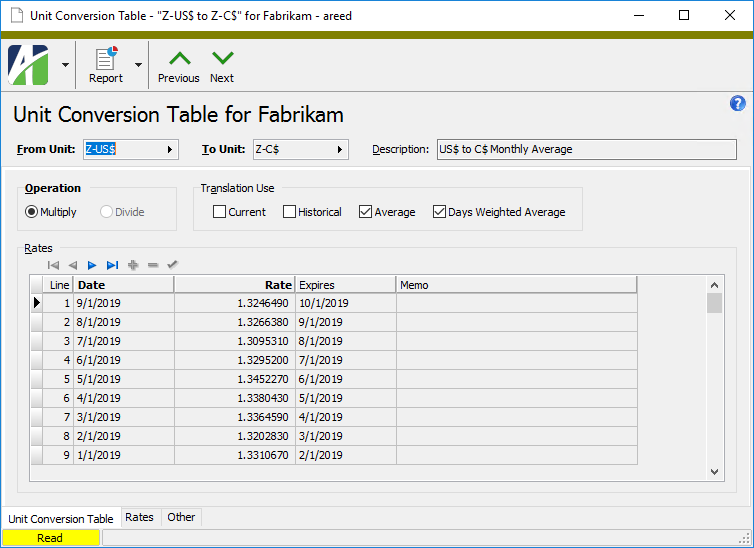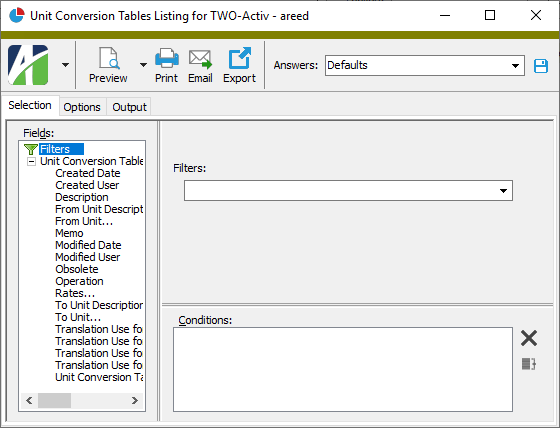Unit conversion tables
Note
In ActivReporter, unit conversion tables are read-only.
Unit conversion tables define the operation, translation methods, and rates used to convert from one currency to another. These tables are part of the multi-currency feature available in financial designs for performing simple translation between currencies as of a particular date.

Conversion tables/rates must satisfy four constraints:
- Conversion rates must be positive numbers.
- The "from" and "to" unit on a conversion table cannot be the same unit.
- The expiration date of a conversion rate cannot precede its effective date.
- Duplicate conversion rates cannot exist for the same date.
Rather than manually enter conversion rates periodically, you can use automation to perform a regular import of conversion rates.
 Update unit conversion tables with changes in Dynamics GP
Update unit conversion tables with changes in Dynamics GP
When multicurrency setup in Dynamics GP changes, you need to update ActivReporter with those changes. If a change occurs to a currency that is in use, or if a currency in use changes to a different currency, update ActivReporter by right-clicking the Unit Conversion Tables folder and selecting Multicurrency Update from the shortcut menu.
 Unit Conversion Tables Listing
Unit Conversion Tables Listing
Purpose
The Unit Conversion Tables Listing provides a list of unit conversion tables defined in the General Ledger.
Content
For each unit conversion table included on the report, the listing shows:
- "from" unit
- "to" unit
- description
- operation (multiply or divide)
- translation use.
In addition, you can include one or more of the following:
- rates (effective dates, rate, memo)
- timestamps
- memos
- custom fields.
The following total appears on the report:
- record count.
Print the report
- In the Navigation pane, highlight the ActivReporter > Setup > Unit Conversion Tables folder.
- Start the report set-up wizard.
- To report on all or a filtered subset of unit conversion tables:
- Right-click the Unit Conversion Tables folder and select Select and Report > Unit Conversion Tables Listing from the shortcut menu.
- On the Selection tab, define any filters you want to apply to the data.

- To report on specifically selected unit conversion tables:
- In the HD view, select the unit conversion tables to include on the report. You can use Ctrl and/or Shift selection to select multiple records.
- Click
 .
.
- To report on a particular unit conversion table from the Unit Conversion Table window:
- In the HD view, locate and double-click the unit conversion table you want to report on. The Unit Conversion Table window opens with the unit conversion table loaded.
- Click
 .
.
- To report on all or a filtered subset of unit conversion tables:
- Select the Options tab.

- Mark the checkbox(es) for the additional information to include:
- Rates
- Timestamps
- Memos
- Custom Fields (only visible if custom fields are set up)
- Select the Output tab.
- In the Design field, look up and select the report design to use.
- In the toolbar, click the icon for the type of output you want:
 - Provides access to two preview options.
- Provides access to two preview options.- Preview - Click the icon or click the drop-down arrow and select Preview from the drop-down menu to view the report in the Crystal Reports viewer.
- Preview to PDF - Click the drop-down arrow next to the icon and select Preview to PDF to view the report in the PDF reader.
 - Opens the Print dialog so that you can select and configure a printer and then print a paper copy of the report.
- Opens the Print dialog so that you can select and configure a printer and then print a paper copy of the report. - Opens the Report Email dialog so that you can address and compose an email that the report will be attached to. For best results, ensure your email client is running before you attempt to send a report via email.
- Opens the Report Email dialog so that you can address and compose an email that the report will be attached to. For best results, ensure your email client is running before you attempt to send a report via email. - Opens the Export Report dialog so that you can save the report to a file. File types include Crystal Reports (.rpt), PDF (.pdf), Microsoft Excel (.xls), Microsoft Word (.doc), rich text (.rtf), and XML (.xml).
- Opens the Export Report dialog so that you can save the report to a file. File types include Crystal Reports (.rpt), PDF (.pdf), Microsoft Excel (.xls), Microsoft Word (.doc), rich text (.rtf), and XML (.xml).
- From
- The email account from which to send the email. Valid options are:
- Windows user default account. Sends email using the user's Windows default email account. For most users, this is the account configured in Outlook or another email client application.
- Server personal. Sends email using the email configuration for the system or company server and the email address on the current user's authorized user record. The authorized user record must have a confirmed email address.
- Server generic. Sends email using the email configuration and "from" address for the system or company server. This option requires "Send generic" access to the Server Email resource.
- To
- The email address(es) to which to send the email. Separate email addresses with semi-colons.
- CC
- The email addresses to copy on the email. Separate email addresses with semi-colons.
- BCC
- The email addresses to blind copy on the email. Separate email addresses with semi-colons.
- Subject
- The subject line.
- Text box
- The body of the email.
Report Email dialog
Data extensions
The following data extensions are available for the report:
- Unit conversion tables
- Unit conversion rates
Unit Conversion Table Record ID
Unit Conversion Table tab
- Multiply
- Divide
- Current. Uses the rate in effect at the end of the accounting period. The calendar used to determine the periods is the one associated with each account (if one of the segments requires a calendar) or the default calendar.
- Historical. Uses the rate in effect on the transaction date.
- Average. Uses a per period average rate. The calendar used to determine the periods is the one associated with each account (if one of the segments requires a calendar) or the default calendar. The following calculation is used:
SUM(Rates)/Number of Rates
- Days Weighted Average. Uses a per period weighted average rate. The calendar used to determine the periods is the one associated with each account (if one of the segments requires a calendar) or the default calendar. The following calculation is used:
SUM(Rate*Days)/SUM(Days)
Rates tab
The Unit Conversion Rates pane shows the Unit Conversion Rates HD view filtered to show all rates for the selected unit conversion table.
Double-click a row in the pane to drill down to its related record in the Unit Conversion Table window with focus on the selected conversion rate.
Custom tab
This tab is visible if custom fields exist for the entity. At a minimum, if there are custom fields, a Fields subtab will be present. One or more additional categories of subtabs may also be visible.
Fields subtab
This tab prompts for values for any custom fields set up for entity records of this entity type. Respond to the prompts as appropriate.
References subtab
This tab is visible if other records reference the current record.
Exchange Folder subtab
This tab is visible only if you set up a custom field with a data type of "Exchange Folder". The label on this tab is the name assigned to the custom field.
This tab shows the contents of the specified Exchange folder.
File subtab
This tab is visible only if you set up a custom field with a data type of "File". The label on the tab is the name assigned to the custom field.
This tab renders the contents of the specified file according to its file type.
Internet Address subtab
This tab is visible only if you set up a custom field with a data type of "Internet Address". The label on this tab is the name assigned to the custom field.
This tab shows the contents of the specified web page.
Network Folder subtab
This tab is visible only if you set up a custom field with a data type of "Network Folder". The label on this tab is the name assigned to the custom field.
This tab shows the contents of the specified network folder.
Other tab
Developer tab
This tab is visible only when developer features are enabled.
Automation subtab
This subtab shows field names and values for the current data record. Use the information in the subtab to assist when creating automation objects such as bots and import files. The field names and field values can be copied from the text box and pasted directly into your code or application. To copy content from the text box, highlight the content to copy and press Ctrl+C or right-click your selection and select Copy from the context menu.
Export (XML) subtab
This subtab shows the XML syntax for exporting the selected data record. The syntax can be copied from the text box as an exemplar for creating your own automation objects for bots, import files, ActivWebAPI, etc. To copy content from the text box, highlight the content to copy and press Ctrl+C or right-click your selection and select Copy from the context menu.
Import (XML) subtab
This subtab allows you to select a file for import and shows the XML syntax for importing data records. Use the subtab to explore the XML syntax for importing data records. In particular, you can investigate the syntax which results when using Data.Import and ActivWebAPI data POST and DELETE routes.
Change Log (XML) subtab
This subtab is visible only when the Enable Change Logs option is marked in System Options or Company Options (depending on whether the feature applies at the system or the company level). This is the default setting when developer features are enabled.
This subtab allows you to investigate changes to the current data record. The syntax can be copied for use in bots, dashboards, ActivWebAPI, and other automation. To copy content from the text box, highlight the content to copy and press Ctrl+C or right-click your selection and select Copy from the context menu.
Select Statement (SQL) subtab
This subtab allows you to investigate the SQL select statement used to retrieve the current data record. The syntax can be copied as an exemplar for data sources and other automation. To copy content from the text box, highlight the content to copy and press Ctrl+C or right-click your selection and select Copy from the context menu.
Unit conversion tables security
Common accesses available on unit conversion tables
| Access | A user with this access can... |
|---|---|
| Data | Have read-only access to unit conversion tables from anywhere in the software (e.g., field validations, filters, date expressions). |
| Export | Export unit conversion table records from ActivReporter. |
| Read | Have read-only access to unit conversion table records. |
| Report | Run reports with unit conversion table information. |
| Report Designs | Create and edit report designs with unit conversion table information. This access enables the Report Designs button on the Output tab of report dialogs. |
| Shared Answers | Create and edit saved answers related to unit conversion tables. |
| Shared Filters | Create and edit shared filters on unit conversion tables. |
| Visible | View the Unit Conversion Tables folder in the Navigation pane. |